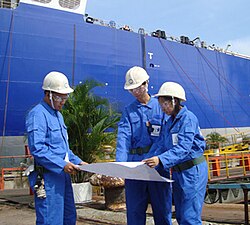Marine engineering

Marine engineering is like building giant machines and structures to ride on the big water areas like oceans, seas, and rivers. You know how you build a sandcastle, but if you want to build a castle on water, you need a lot of special things to make it work. Marine engineers build these things.
They start with designing plans for ships, submarines, boats and oil platforms. These plans show how big and heavy the machine will be, how it will float in water, and how it will move. Then, marine engineers use maths and science to find out what kind of materials and engines to use, to make sure the machine works safely and efficiently.
Once the plans are ready, marine engineers work with a team to build the complex structure piece by piece. They need to be careful with every detail, like making sure the ship or platform is strong enough to withstand big waves and harsh weather. Marine engineers also need to make sure the parts work together, like fitting the propellers and engines to make the ship move forward or designing the pipes to carry oil, gas or water.
After the machine is built, marine engineers run tests to make sure it's working properly. They check if everything is stable and if it can go fast or slow. They also make sure it's safe for people and cargo to move around on the machine. Finally, they take care of the machine by fixing problems, replacing broken parts, and making sure it's environmentally friendly.
Overall, marine engineering is a challenging but exciting field that lets people build amazing things that can travel and explore the world's oceans while keeping people and goods safe.
They start with designing plans for ships, submarines, boats and oil platforms. These plans show how big and heavy the machine will be, how it will float in water, and how it will move. Then, marine engineers use maths and science to find out what kind of materials and engines to use, to make sure the machine works safely and efficiently.
Once the plans are ready, marine engineers work with a team to build the complex structure piece by piece. They need to be careful with every detail, like making sure the ship or platform is strong enough to withstand big waves and harsh weather. Marine engineers also need to make sure the parts work together, like fitting the propellers and engines to make the ship move forward or designing the pipes to carry oil, gas or water.
After the machine is built, marine engineers run tests to make sure it's working properly. They check if everything is stable and if it can go fast or slow. They also make sure it's safe for people and cargo to move around on the machine. Finally, they take care of the machine by fixing problems, replacing broken parts, and making sure it's environmentally friendly.
Overall, marine engineering is a challenging but exciting field that lets people build amazing things that can travel and explore the world's oceans while keeping people and goods safe.
Related topics others have asked about:
